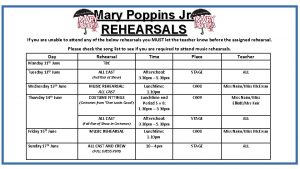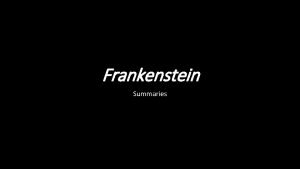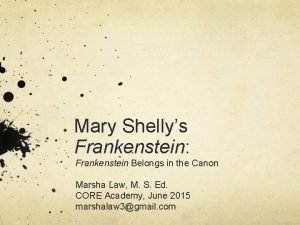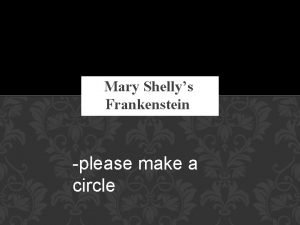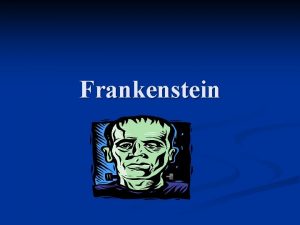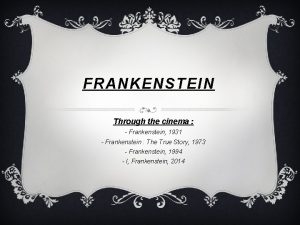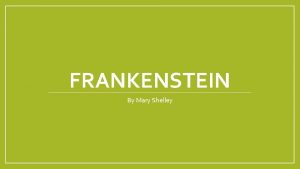Mary Shellys Frankenstein The Movie Soundtrack Soundtrack You







- Slides: 7

Mary Shelly’s Frankenstein The Movie Soundtrack

Soundtrack You are to create a soundtrack for Mary Shelley’s Frankenstein for the following scenes: › › › › Creation (5) Nervous Energy (6) Learning a new Language (12) Creature’s Request and Denial(17 -19) Henry (20) Wedding Night (23) The Chase (24) Namlessness/Despair(24) Put together a playlist to be used as the soundtrack for the movie Frankenstein (tie your choices together so that the music relates to the various themes presented in the novel) Explain your choice of music for each scene (analysis slide) Use songs where the lyrics not only tell the story, but the music also sets the mood (expresses the sentiment/feelings of the scene; provides a Gothic feel) Present your soundtrack in 7 – 10 minutes (your chosen format) No profanity, sexual content (suggestions), no derogatory language, no illegal drugs or alcohol references

Themes Obsession/revenge Seeking knowledge for glory’s sake Importance of friendship Parental responsibility Rejection/alienation of individuals Positive/negative consequences Depression

Written Analysis For each song, provide a detailed paragraph of your analysis Explain why you chose that particular song for that scene/theme Cite at least one line or musical movement that helps express the feeling/sentiment of the character and/or scene/theme Type, double-spaced; font no larger than 12, no smaller than 11 Provide song scene title and song title in the heading before each paragraph

Timeline and Suggested Activities Day 1 – introduce project; clarify instructions and research possible selections for connection to themes/scenes (plan) Day 2 - begin outline for soundtrack; put music and scenes together and analyze content/movement for theme; write draft for each pairing; select clips/pictures for trailer/powerpoint (if applicable) (plan) Day 3 – review draft and revise, edit, rewrite; produce and prepare for presentation Day 4 – present final draft of soundtrack (publish)

Common Core State Standards Addressed Key Ideas and Details 1. Cite strong and thorough textual evidence to support analysis of what the text says explicitly as well as inferences drawn from the text, including determining where the text leaves matters uncertain. 2. Determine two or more themes or central ideas of a text and analyze their development over the course of the text, including how they interact and build on one another to produce a complex account; provide an objective summary of the text. 3. Analyze the impact of the author’s choices regarding how to develop and relate elements of a story or drama (e. g. , where a story is set, how the action is ordered, how the characters are introduced and developed). Presentation of Knowledge and Ideas 4. Present information, findings, and supporting evidence, conveying a clear and distinct perspective, such that listeners can follow the line of reasoning, alternative or opposing perspectives are addressed, and the organization, development, substance, and style are appropriate to purpose, audience, and a range of formal and informal tasks. 5. Make strategic use of digital media (e. g. , textual, graphical, audio, visual, and interactive elements) in presentations to enhance understanding of findings, reasoning, and evidence and to add interest. 6. Adapt speech to a variety of contexts and tasks, demonstrating a command of formal English when indicated or appropriate. Production and Distribution of Writing 4. Produce clear and coherent writing in which the development, organization, and style are appropriate to task, purpose, and audience. (Grade-specific expectations for writing types are defined in standards 1– 3 above. ) 5. Develop and strengthen writing as needed by planning, revising, editing, rewriting, or trying a new approach, focusing on addressing what is most significant for a specific purpose and audience. 6. Use technology, including the Internet, to produce, publish, and update individual or shared writing products in response to ongoing feedback, including new arguments or information.

Sources http: //www. corestandards. org/the-standards/english-language-artsstandards/writing-6 -12/grade-11 -12/
